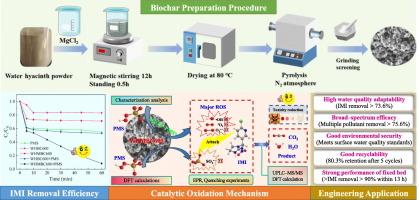Activation of peroxymonosulfate by magnesium−modified biochar for the degradation of imidacloprid: Effectiveness and mechanisms
IF 13.2
1区 工程技术
Q1 ENGINEERING, CHEMICAL
引用次数: 0
Abstract
The increasing environmental contamination by imidacloprid (IMI), a widely used neonicotinoid pesticides, has raised significant concern. While peroxymonosulfate (PMS) oxidation has shown great promise for removing such toxic organic compounds due to its high efficiency, the potential secondary pollution caused by toxic metal leaching from transition metal–based catalysts remains a critical challenge. To address this issue, we developed an environmentally friendly magnesium–modified biochar (WHMBC600) using water hyacinth as a carbon source and MgCl2 as a modifier. The synthesized WHMBC600 exhibited excellent physicochemical properties, including substantial pore volume, high specific surface area, and abundant surface hydroxyl groups (Metal–OH), which collectively functioned as active sites for PMS activation. The WHMBC600/PMS system achieved 91.7 % removal of IMI within 60 min, demonstrating remarkable degradation efficiency. Comprehensive characterization, including DFT calculations, in situ Raman spectroscopy, and other analytical techniques revealed that magnesium modification significantly enhanced the electron transfer capacity and PMS adsorption capability of the WHMBC600 catalyst. These finding confirm that the metal–OH groups serve as the key active site for activating PMS to produce reactive oxygen species (ROS). Electron paramagnetic resonance (EPR) analysis combined with quenching experiments identified ·OH, 1O2, and O2•– as the predominant ROS responsible for IMI degradation, with intermediate products clearly determined. This study not only provides an effective strategy for water hyacinth waste utilization but also establishes Mg–modified biochar as a sustainable, environmentally friendly, and efficient catalyst for water and wastewater treatment.

镁改性生物炭活化过氧单硫酸酯降解吡虫啉的效果和机理
吡虫啉(IMI)是一种广泛使用的新烟碱类杀虫剂,其对环境的污染日益严重,引起了人们的极大关注。虽然过氧单硫酸盐(PMS)氧化因其高效率而在去除这些有毒有机化合物方面显示出很大的希望,但过渡金属基催化剂中有毒金属浸出造成的潜在二次污染仍然是一个关键挑战。为了解决这一问题,我们以水葫芦为碳源,以MgCl2为改性剂,开发了一种环保型镁改性生物炭(WHMBC600)。合成的WHMBC600具有优异的物理化学性能,包括大孔隙体积、高比表面积和丰富的表面羟基(Metal-OH),它们共同作为PMS活化的活性位点。WHMBC600/PMS系统在60 min内对IMI的去除率达到91.7 %,表现出显著的降解效率。综合表征,包括DFT计算、原位拉曼光谱等分析技术表明,镁改性显著增强了WHMBC600催化剂的电子转移能力和PMS吸附能力。这些发现证实了金属- oh基团是激活PMS产生活性氧(ROS)的关键活性位点。电子顺磁共振(EPR)分析结合猝灭实验,确定了·OH、1O2和O2•-是IMI降解的主要ROS,并明确了中间产物。本研究不仅为水葫芦废弃物的资源化利用提供了有效的策略,而且还确立了镁改性生物炭作为一种可持续、环保、高效的水和废水处理催化剂的地位。
本文章由计算机程序翻译,如有差异,请以英文原文为准。
求助全文
约1分钟内获得全文
求助全文
来源期刊

Chemical Engineering Journal
工程技术-工程:化工
CiteScore
21.70
自引率
9.30%
发文量
6781
审稿时长
2.4 months
期刊介绍:
The Chemical Engineering Journal is an international research journal that invites contributions of original and novel fundamental research. It aims to provide an international platform for presenting original fundamental research, interpretative reviews, and discussions on new developments in chemical engineering. The journal welcomes papers that describe novel theory and its practical application, as well as those that demonstrate the transfer of techniques from other disciplines. It also welcomes reports on carefully conducted experimental work that is soundly interpreted. The main focus of the journal is on original and rigorous research results that have broad significance. The Catalysis section within the Chemical Engineering Journal focuses specifically on Experimental and Theoretical studies in the fields of heterogeneous catalysis, molecular catalysis, and biocatalysis. These studies have industrial impact on various sectors such as chemicals, energy, materials, foods, healthcare, and environmental protection.
 求助内容:
求助内容: 应助结果提醒方式:
应助结果提醒方式:


